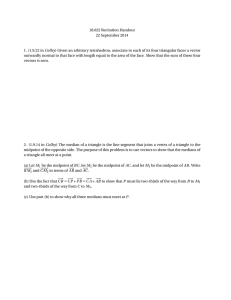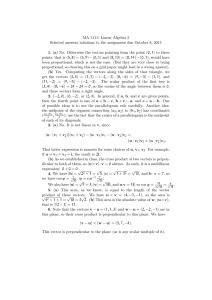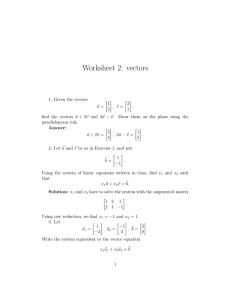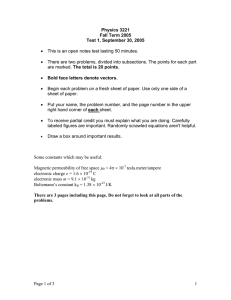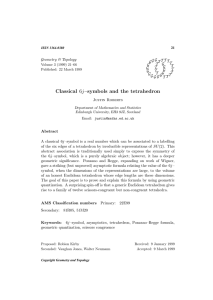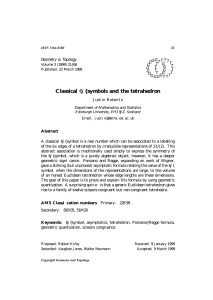18.022 Recitation Handout (with solutions) 22 September 2014 Colley
advertisement
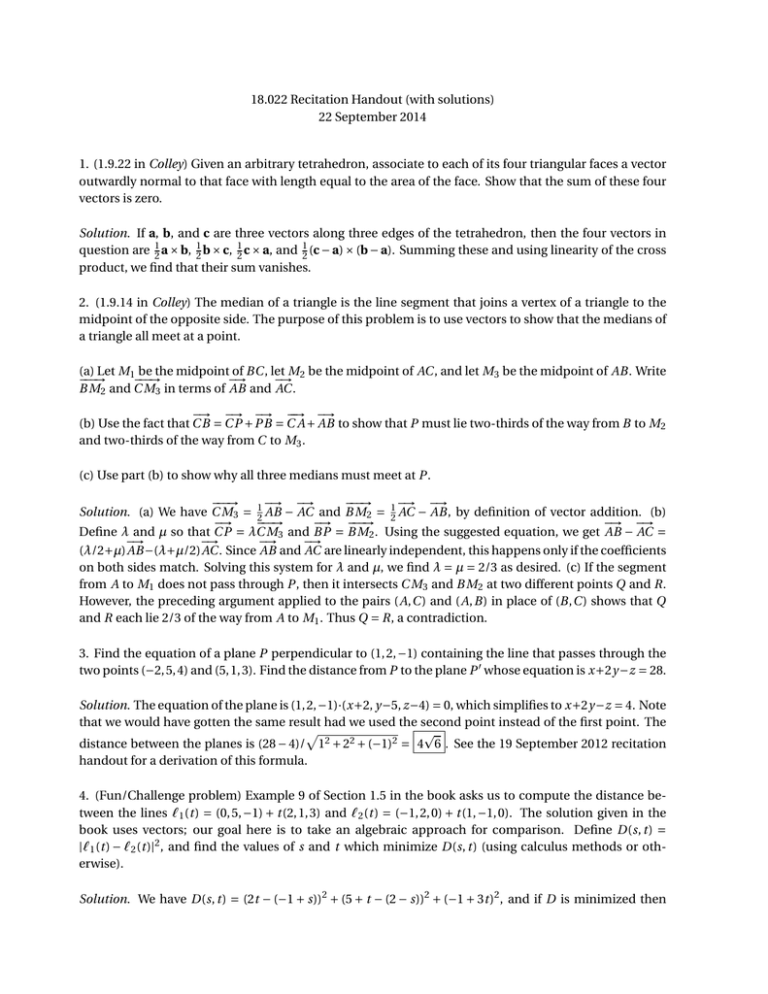
18.022 Recitation Handout (with solutions) 22 September 2014 1. (1.9.22 in Colley) Given an arbitrary tetrahedron, associate to each of its four triangular faces a vector outwardly normal to that face with length equal to the area of the face. Show that the sum of these four vectors is zero. Solution. If a, b, and c are three vectors along three edges of the tetrahedron, then the four vectors in question are 12 a × b, 21 b × c, 12 c × a, and 21 (c − a) × (b − a). Summing these and using linearity of the cross product, we find that their sum vanishes. 2. (1.9.14 in Colley) The median of a triangle is the line segment that joins a vertex of a triangle to the midpoint of the opposite side. The purpose of this problem is to use vectors to show that the medians of a triangle all meet at a point. (a) Let M 1 be the midpoint of BC , let M 2 be the midpoint of AC , and let M 3 be the midpoint of AB . Write −−−→ −−−→ −→ −→ B M 2 and C M 3 in terms of AB and AC . −→ −→ −→ −−→ −→ (b) Use the fact that C B = C P + P B = C A + AB to show that P must lie two-thirds of the way from B to M 2 and two-thirds of the way from C to M 3 . (c) Use part (b) to show why all three medians must meet at P . −−−→ −→ −→ −−−→ −→ −→ Solution. (a) We have C M 3 = 12 AB − AC and B M 2 = 12 AC − AB , by definition of vector addition. (b) −→ −−−→ −→ −−−→ −→ −→ Define λ and µ so that C P = λC M 3 and B P = B M 2 . Using the suggested equation, we get AB − AC = −→ −→ −→ −→ (λ/2+µ) AB −(λ+µ/2) AC . Since AB and AC are linearly independent, this happens only if the coefficients on both sides match. Solving this system for λ and µ, we find λ = µ = 2/3 as desired. (c) If the segment from A to M 1 does not pass through P , then it intersects C M 3 and B M 2 at two different points Q and R. However, the preceding argument applied to the pairs (A,C ) and (A, B ) in place of (B,C ) shows that Q and R each lie 2/3 of the way from A to M 1 . Thus Q = R, a contradiction. 3. Find the equation of a plane P perpendicular to (1, 2, −1) containing the line that passes through the two points (−2, 5, 4) and (5, 1, 3). Find the distance from P to the plane P 0 whose equation is x+2y −z = 28. Solution. The equation of the plane is (1, 2, −1)·(x+2, y−5, z−4) = 0, which simplifies to x+2y−z = 4. Note that we would have gotten the same result had we used the second point instead of the first point. The p p distance between the planes is (28 − 4)/ 12 + 22 + (−1)2 = 4 6 . See the 19 September 2012 recitation handout for a derivation of this formula. 4. (Fun/Challenge problem) Example 9 of Section 1.5 in the book asks us to compute the distance between the lines `1 (t ) = (0, 5, −1) + t (2, 1, 3) and `2 (t ) = (−1, 2, 0) + t (1, −1, 0). The solution given in the book uses vectors; our goal here is to take an algebraic approach for comparison. Define D(s, t ) = |`1 (t ) − `2 (t )|2 , and find the values of s and t which minimize D(s, t ) (using calculus methods or otherwise). Solution. We have D(s, t ) = (2t − (−1 + s))2 + (5 + t − (2 − s))2 + (−1 + 3t )2 , and if D is minimized then ∂D/∂s = 0 and ∂D/∂t = 0. These two derivatives are ∂D/∂s = 4 + 4s − 2t and ∂D/∂t = 4 − 2s + 28t . Setting each of these equal to 0 and solving the system, we find s = −10/9 and t = −2/9. Substituting into D(s, t ), we find that the minimal squared distance is 25/3.
